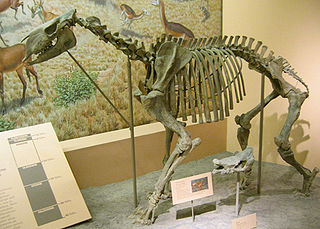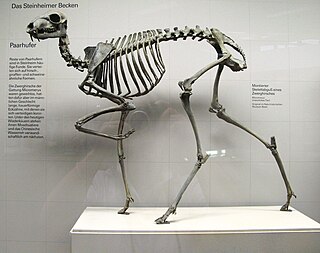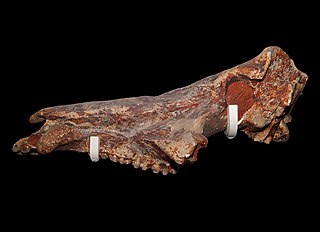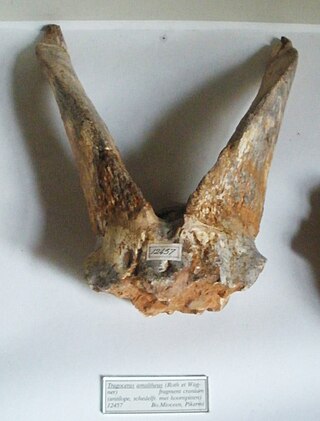
Amphicyonidae is an extinct family of terrestrial carnivorans belonging to the suborder Caniformia. They first appeared in North America in the middle Eocene, spread to Europe by the late Eocene, and further spread to Asia and Africa by the early Miocene. They had largely disappeared worldwide by the late Miocene, with the latest recorded species at the end of the Miocene in Africa. They were among the first carnivorans to evolve large body size. Amphicyonids are colloquially referred to as "bear-dogs".

Chalicotheriidae is an extinct family of herbivorous, odd-toed ungulate (perissodactyl) mammals that lived in North America, Eurasia, and Africa from the Middle Eocene to the Early Pleistocene. They are often called chalicotheres, a term which is also applied to the broader grouping of Chalicotherioidea. They are noted for their unusual morphology compared to other ungulates, such as their clawed forelimbs. Members of the subfamily Chalicotheriinae developed elongate gorilla-like forelimbs that are thought to have been used to grasp vegetation. They are thought to have been browsers on foliage as well as possibly bark and fruit.

Ancylotherium is an extinct genus of the family Chalicotheriidae, subfamily Schizotheriinae, endemic to Europe, Asia, and Africa during the Late Miocene-Early Pleistocene, existing for approximately 9.8 million years.

The John Day Formation is a series of rock strata exposed in the Picture Gorge district of the John Day River basin and elsewhere in north-central Oregon in the United States. The Picture Gorge exposure lies east of the Blue Mountain uplift, which cuts southwest–northeast through the Horse Heaven mining district northeast of Madras. Aside from the Picture Gorge district, which defines the type, the formation is visible on the surface in two other areas: another exposure is in the Warm Springs district west of the uplift, between it and the Cascade Range, and the third is along the south side of the Ochoco Mountains. All three exposures, consisting mainly of tuffaceous sediments and pyroclastic rock rich in silica, lie unconformably between the older rocks of the Clarno Formation below and Columbia River basalts above.

Boselaphini is a tribe of bovines. It contains only two extant genera, each with a single extant species.

Micromeryx is an extinct genus of musk deer that lived during the Miocene epoch. Fossil remains were found in Europe and Asia. The earliest record (MN4) of the genus comes from the Sibnica 4 paleontological site near Rekovac in Serbia.

Ceratotherium neumayri is a fossil species of rhinoceros from the Late Miocene (Vallesian-Turolian) of the Balkans and Western Asia, with remains known from Greece, Bulgaria, Iran, and Anatolia in Turkey.

Paracamelus is an extinct genus of camel in the family Camelidae. It originated in North America Around 8-7 Ma, and crossed the Beringian land bridge into Eurasia during the Late Miocene, about 6 million years ago (Ma). It is the presumed ancestor to living camels of the genus Camelus.

Soergelia is a genus of extinct ovibovine caprine that was common across Europe, North America and Asia in the Pleistocene epoch.

Gazellospira is an extinct genus of antelope from the Miocene to Pleistocene of Europe and Asia.

Microstonyx was an extinct genus of suid that existed during the Miocene in Asia and Europe.
Bruce J. MacFadden is an American vertebrate paleontologist, a significant figure in his field, currently a Distinguished Professor at University of Florida.

The Liushu Formation is a geological formation in Gansu province, China that spans up to 100 m thick and is widely distributed within the Linxia Basin, with a paleomagnetic age between 11 and 6.4 mya.

Tragoportax is an extinct genus of bovid ungulate. It lived from the upper Miocene to the earliest Pliocene, and its fossils have been found in southeastern Europe, parts of Africa, and the Indian subcontinent. Tragoportax was formerly considered a close relative of the extant nilgai, though more recent studies suggest that it, and several other Miocene "boselaphins", formed a tribe of their own. The number of Tragoportax species has varied over the years, and some have been reassigned to the related genus Miotragocerus. The first Tragoportax specimens were discovered in Greece, and were originally assigned to Capra. Subsequently, they were reassigned to Tragocerus. This genus name was preoccupied by a beetle, and thus Tragoportax is the correct name.
Tethytragus was a genus of caprine bovid that lived in the Middle and Late Miocene.
Palaeoreas was a genus of Miocene bovid from Europe.
Parastrepsiceros is an extinct genus of Pliocene bovid from Eurasia.
Sporadotragus was a genus of caprine bovid that inhabited Eurasia during the Miocene epoch.
Qurliqnoria is an extinct genus of caprine bovid that inhabited Eurasia during the Neogene period.
Gangraia is an extinct genus of bovid that lived in Turkey during the Miocene epoch. It is known from a single species, Gangraia anatolica.












